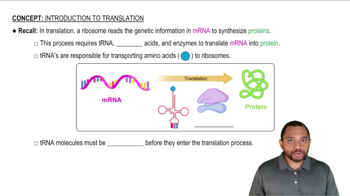A specific virus contains RNA as its genetic material.
a. Why might reverse transcription be used in the life cycle of this type of virus?
 Verified step by step guidance
Verified step by step guidance Verified video answer for a similar problem:
Verified video answer for a similar problem:



 2:42m
2:42mMaster Translation: Protein Synthesis Concept 1 with a bite sized video explanation from Jules
Start learning